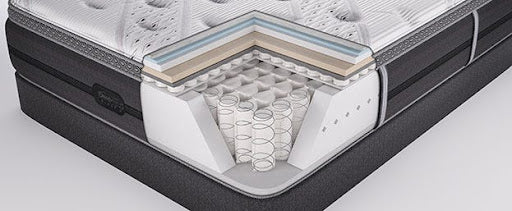What's Inside a Mattress?
October 13, 2023
All mattresses have three major components:
- Quilt
- Comfort Layers
- Support System
By understanding what each of these components adds to the mattress, you can better understand the product as a whole.

The Quilt
The quilt section of the mattress at the top is more important than most people think. The quilt can sometimes offer cooling properties as well as added comfort. For example, quilts containing Tencel material help lower your body temperature. This helps you to fall asleep faster and to stay asleep longer.
Different manufacturers use different materials in their quilts. Some brands even offer 100% unique quilts such as Vispring's Belgian Damask cover.
This cover is woven so tightly that dust mites and skin cells cannot penetrate it. Still, other manufacturers use materials like tufted natural cotton or bamboo fiber in their quilts. While shopping for a new mattress, the quilt material should be a part of your considerations.
Comfort Layers
The comfort layers in a mattress will determine its comfort (firm, plush, medium, etc.) and price. The greater the number of high-quality comfort materials the longer the comfort life. But quantity does not equal and isn't better than quality!
Six inches of cheap foam will not be more comfortable than four inches of high-quality foam. So be sure to consider the types of comfort foams that each mattress offers while shopping.
We'd like to list all of the different comfort layers available in modern mattresses here but there are far too many. The best you can do is pay attention to the features each foam layer has to offer.
Gel memory foam will relieve pressure while also siphoning heat away from your body. Latex foam is a natural material that gives you conforming support and lasts for a very long time. High-density foams are a better option than regular polyurethane foam. The higher the quality foam the better comfort you'll get for a lot longer than cheaper materials will last.
Support System
Support systems are a little easier to talk about. Basically, you have innerspring, memory foam, latex, and hybrid support systems. Each category does have some subcategory breakouts (innerspring, tied coils, wrapped coils, etc.)
Here are some general guidelines for support systems:
- Innerspring mattresses are the least expensive - they use a few different types of coil systems (continuous coil, pocketed coil, etc.)
- Memory foam mattresses offer better pressure relief and a longer comfort life - foam core for support
- Latex mattresses are similar to memory foam but retain less heat - latex hybrids have a coil support system, latex foam mattresses have a foam core
- Hybrid mattresses have the traditional innerspring feel with the added benefit of memory or latex foam - use a coil support system
One of these support systems may work better for you than the others. It all depends on your sleep habits, comfort preference, and preferred sleep position. The comfort layers do play an important role in the comfort of the mattress. However, the properties of the support system are hard to overcome, even with many layers of foam on top of them.
Other Factors
Other components you may want to consider are edge support and the foundation, or box spring. While the foundation isn't part of the mattress itself, it can be important for the comfort and lifespan.
Edge Support
Edge support comes in a few different forms. Border rods are the cheaper version that simply uses metal supports to prevent the edges from collapsing. These aren't very comfortable to sleep on but reinforce the mattress well if you sleep away from the edge.
Foam encasement reinforces the perimeter of the mattress with extra-sturdy foam that helps hold the shape of the mattress. This type of edge support is preferable because it isn't as uncomfortable to sleep on if you end up on the edge of the mattress.
The most premium type of edge support is coil based. It is the most durable while remaining comfortable, and it is more breathable than a foam encased edge so it doesn't trap heat.
Read more about this is our article: What is Edge Support?
Foundation
Today, box springs and foundations are essentially the same. Some manufacturers still use a true box spring that has a coil or modular coil spring system within it. The coils act like little shock absorbers, so when force and weight are applied to the top of the mattress, the box spring will give slightly underneath.
Recent advances in technology have eliminated the need for a true box spring. Nowadays, most mattresses are made to function with a foundation instead.
A foundation is just framed wood or steel and it has no springs. They guarantee that your mattress has a hard flat surface to sit on. While you can achieve this same effect by simply putting your mattress on the floor, some people like the aesthetic.
Having a foundation also lifts the mattress higher off the floor thereby making it easier to get into and out of bed. It's important to note that many mattress warranties do require the use of a foundation or a box spring. Otherwise, the surface you do use can have a negative impact on the life of the mattress.
Still Need Help?
Try not to get overwhelmed by technical jargon when you're shopping for your new mattress. Keep this overview in mind when doing research, and it will help you understand what's what so you can make the right choice.
If you'd like more help finding the right mattress for you, you can speak with one of our friendly experts by calling 1-800-455-1052. Good luck finding the perfect mattress to provide you a good night's sleep!


